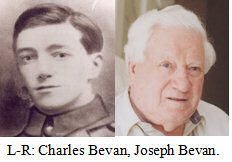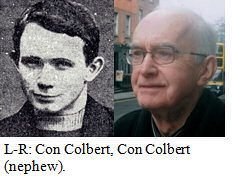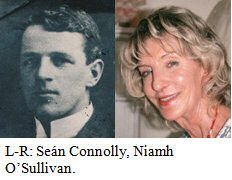Tom Duffy recalls his grandparents, both of whom were involved in the 1916 Rising. His grandmother Bridget Duffy’s involvement was through the Labour movement. She was one of the founder members of the Irish Women Workers Union, along with Rosie Hackett. He describes the origin of the Irish Citizen Army which, he says, had a Labour rather than a nationalist root. Tom’s grandfather, Patrick Duffy, was involved with O’Tooles GAA Club. The GAA in the city centre was political with regard to the Irish Volunteers. O’Tooles was formed on Seville Place and the club supplied the main core of the Dublin team which lined out to play Tipperary on Bloody Sunday. Patrick Duffy’s mother, Rose Flood, was considered to be republican. Patrick himself came from Finglas and Bridget was from the Donabate area. Bridget was garrisoned at City Hall at Easter Week. She was on the roof with Seán Connolly who was to become the first fatality of the Rising. She attended to him following his fatal shooting, and her apron was stained with his blood. The family donated this historic artefact to Kilmainham so it is now the property of the State which was the family’s wish. Patrick ‘Paddy’ Duffy was stationed at Stephen’s Green during the Rising, moving to the Royal College of Surgeons as a member of Irish Volunteers, though on the day he fought with the Irish Citizen Army. Following his capture he was brought to Richmond Barracks and was later deported. Tom explains that his father believed that Paddy spent two weeks imprisoned in London before being moved on. Tom discusses the location of the Duffy family home in Common Street and says that his grandfather’s brothers also took part in the Rising. Paddy trained as a bookbinder with Dollards, a large firm which worked on government printing contracts. Though he had been sent to Frongoch, the firm again employed him on his return to Dublin. In the 1880s, O’Tooles GAA Club was founded at 100, Seville Place, Tom explains, as he describes the background and history of the club for which his grandfather played football. At O’Tooles, a pipe band was founded in 1910, and also founded was a drama society in which Tom Clarke and Seán O’Casey were involved. Seán MacDermott was a non-playing member of the club. All the Duffys were members, and Tom recalls Frank Callan, a local teacher, who was iinfluential in the club and exerted a republican influence on club members. Paddy Duffy had five brothers. His younger brothers Michael and Tom were those most involved in the War of Independence. Tom was a member of Collins’s Squad involved in shootings at Upper Mount Street on 21st November 1920. Michael was involved in the planning as he apparently told Tom where he would be. Tom Duffy made a witness statement to the Bureau of Military History. Rosie Hackett and Bridget Duffy were lifelong friends. Rosie ran the shop at Liberty Hall and she was Tom’s father’s godmother. Tom remembers meeting Rosie several times during his childhood. When Tom was born, his grandfather Paddy was living in Munster Street in Phibsboro. He talks about his parents’ early married life and their plans to emigrate for economic reasons though, because of his mother Bridget’s ill-health, Thomas and his wife Kathleen decided not to go to Canada. However, they did go to St Albans for two years where Thomas worked at Campfield Press, run by the Salvation Army. The couple returned to Dublin for Tom’s birth and his father then worked at Hely Thom and the new family moved in with his father Paddy at Munster Street. Paddy Duffy died in 1960. Tom remembers his father Thomas talking about his parents, mainly about his mother Bridget who had a strong personality. With Dr. Kathleen Lynn she was much involved with the foundation of St Ultan’s Hospital for children. Bridget was trained as a nurse ‘on the job’ through the Rising, her grandson says, and in so far as he knows, her husband Paddy did not talk much about his experiences. He explains that the lasting memory was of the Civil War during which Paddy served as Commander at the Curragh. Despite this, he had maintained friendships with people who were on the opposing side in the conflict. Bridget Duffy received 1916 and War of Independence medals. Her daughter Maureen had nursed alongside her mother, and she had stories about the people who visited the family home, including Kitty Kiernan and Harry Boland. As Tom explains, the house was situated in a strong inner city republican area. He explains that many people from the area were close to Michael Collins and took the Free State side. The Duffy family is in possession of family memorabilia from the period. Paddy Duffy kept his internment paper from Frongoch, and Tom reflects on what the men would have discussed there and the planning for the War of Independence. He recalls the fact that his father Thomas had a republican outlook on life, though not all of the family had an interest. Thomas worked with his father Paddy at Hely Thom and was probably closest to him. Paddy had later operated his own small printing press. At Frongoch he became friendly with a German prisoner who was also a printer. Tom tells an interesting story about a ticket printer sent by this German man to his grandfather, who unfortunately could not pay the customs duty due, thus a business opportunity was lost. Probably because of his activities during the War of Independence, Paddy set up his own business while Thomas was an apprentice at Hely Thom. Tom explains the reason why his father, Thomas Duffy, set up Duffy Bookbinders in Finglas East, where Tom and his brother Patrick served their time. When the business expanded it was moved to Seville Place. Shortly after the move his father became unwell, and the two brothers took over the business which still operates from the same location. Tom discusses the houses on Seville Place and the history of the area, remarking that it is a shame that 100 Seville Place, where O’Tooles GAA Club was founded and which is associated with a number of people who were active in nationalism, is now derelict. Jimmy Wren’s book A Centenary History of O’Tooles is mentioned. Tom talks about his granduncle Tom Duffy’s career in the Irish Army after Independence. Commandant Thomas Duffy gave a witness statement, numbered 1409, to the Bureau of Military History in 1956. A handwritten document, namely a statement which is very likely to have also been written by Tom and found in the Duffy home, is described. Tom reads from this statement which relates to the proposed rescue of Kevin Barry. The attack by E Company on a hotel on the North Wall is discussed. This hotel had been taken over by K Company of the ‘Auxiliaries’ which had been responsible for the burning of Cork city. The many locations in which Bridget and Patrick Duffy lived are recalled but Rush is remembered as a particularly good location for the family. Tom has his grandmother’s medals while his uncle Paddy’s family has those of his grandfather. His family history means a lot to Tom but he says that the official centenary commemorations will not be important to him personally. His preference is to walk the places where his grandparents were. He refers back to the subject of Bridget’s apron which she wore on the fateful day of Seán Connolly’s death, saying that it is valuable as an historical artefact from the Irish Citizen Army. He considers the role of the 1916 relatives in the 2016 commemorations, and his opinion is that direct descendants should be provided with tickets, though perhaps not members of the extended families.

Tom Duffy (b. 1955)
Tom Duffy (b. 1955)
€10.00 – €20.00
Additional information
| Type: | MP3 |
|---|---|
| Audio series: | The 1916 Rising Oral History Collections |
| Bitrate: | 128 kbps |
| Download time limit: | 48 hours |
| File size(s): | 43.40 MB |
| Number of files: | |
| Product ID: | CD191602-097 |
| Subject: | Bridget Duffy and Patrick Duffy (Interviewee’s grandparents) |
| Recorded by: | Maurice O’Keeffe – Irish Life and Lore |








